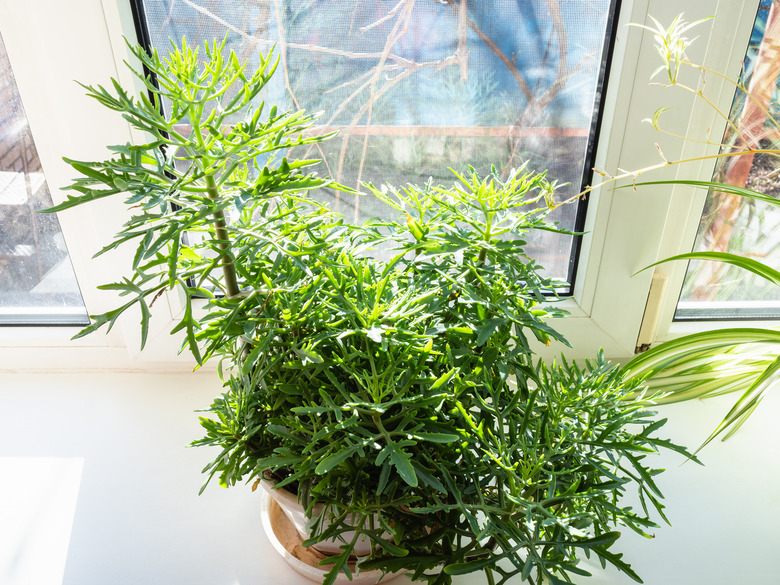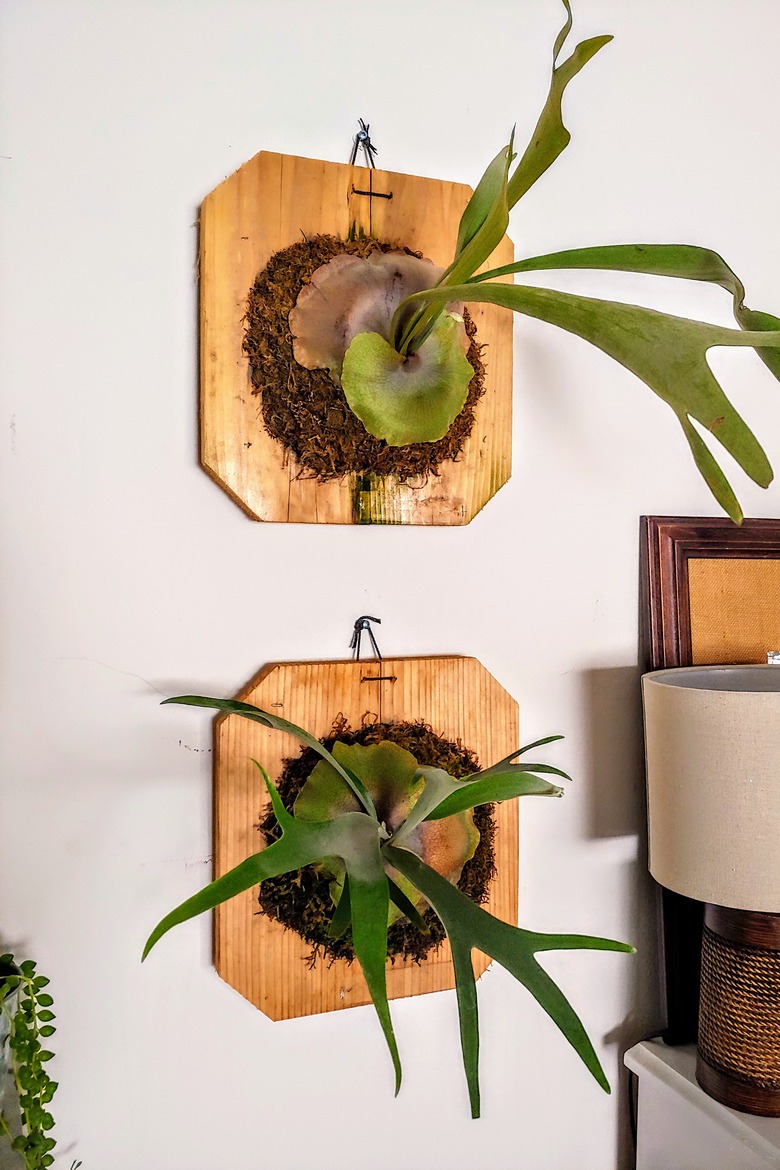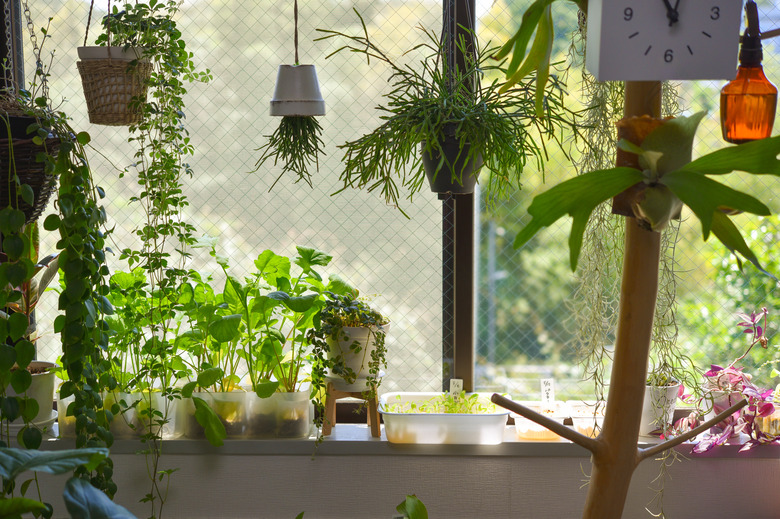How To Care For A Staghorn Fern
We may receive a commission on purchases made from links.
- Best uses for staghorn ferns
- How to care for staghorn ferns
- Soil, light, and water recommendations for staghorn ferns
- Fertilizer recommendations for staghorn ferns
- Humidity and temperature recommendations for staghorn ferns
- How to prune staghorn ferns
- Potting (and repotting) staghorn ferns
- How to propagate staghorn ferns
- Common pests and other problems for staghorn ferns
- Common diseases for staghorn ferns
- Toxicity information about staghorn ferns
Staghorn fern (Platycerium bifurcatum, USDA zones 9-12) is a tropical epiphyte (or air plant) that grows on tree trunks and rocks in its native ranges in Africa, Australia and southeast Asia. The fern's leaves are called fronds. They branch and rebranch in a pattern that resembles the forked antlers of male deer or elk. Staghorn fern has become a popular, easy-care houseplant.
This broadleaf evergreen is valued for its highly unusual, ornamental "antler" fronds. The staghorn fern produces two kinds of fronds. One type is the rounded, sterile fronds (also called basal fronds or shield fronds) found in overlapping layers that cover the root base. The other fronds are bright green or gray-green fertile fronds that grow in the antler branching pattern, leading to the common names staghorn fern or elkhorn fern. There are some 18 different staghorn species, and some of them are tricky to care for. This one, however, is low maintenance and a very good choice for beginners.
Best Uses for Staghorn Ferns
Best Uses for Staghorn Ferns
As an epiphyte, this fern gets its nutrients from the air, not the soil. It uses its roots to hold onto its support structure rather than to penetrate the soil in search of sustenance. In the wild, the roots often attach the plant to the trunks or branches of tropical trees. When the staghorn fern is grown as a houseplant, the roots attach the plant to any attractive support. For example, it makes an impressive houseplant when mounted on a piece of wood, tree fern fiber, bark chunk or interesting rock. These ferns also grow happily in wire baskets.
Staghorns are native to warm locations, and they cannot tolerate cold temperatures. They grow well indoors in the temperatures humans prefer — above 55 degrees Fahrenheit. Place them in a bright location with relatively high humidity. Great locations for a staghorn fern houseplant might include hanging near a bathroom window or positioned above the kitchen sink.
How to Care for Staghorn Ferns
How to Care for Staghorn Ferns
-
Common Name: Staghorn fern
-
Botanical Name: Platycerium bifurcatum
-
Sun Exposure: Bright, indirect light; dappled light; or partial shade
-
Soil Type: Sphagnum moss or other well-drained organic-rich growing medium
-
Mature Size: Individual fronds to 3 feet long, entire plant to 4 feet across
-
When it's in Trouble:
Fronds mold and rot with too much water -
When it's Thriving: With excellent cultural care, leathery gray-green fronds start by growing upright and then droop to form graceful, arching arms
Soil, Light, and Water Recommendations for Staghorn Ferns
Soil, Light, and Water Recommendations for Staghorn Ferns
If you've ever grown orchids, you are familiar with the cultural needs of epiphytes, like the staghorn fern. Epiphytes do not grow in soil in nature but attach themselves to trees. Note that they are not parasites and simply use the tree trunk or branch as a support structure. Just so, a staghorn fern houseplant does not require soil. However, it will need some type of growing medium for the roots to grow into, like sphagnum moss or peat moss. Initially, the fern must be physically attached to the support structure with fishing line, wire or plastic mesh passing through the brown shield-shaped basal fronds. Over time, the roots create their own attachment.
Although ferns are usually considered low-light plants, staghorns should be placed in bright, indirect light for best results. Very shady areas may encourage pests and fungal diseases. Direct sunlight will crisp their fronds.
Staghorn ferns require regular irrigation. They take in moisture through their roots as well as their fronds, so it's best to soak both the basal fronds and the growing medium when you water. Experts recommend that you don't water the fern until it wilts slightly, usually about once a week during warm, dry weather. A wilting fern will quickly perk back up when it is given water, but it will rot and die if overwatered. The plant becomes quite drought resistant as it matures and can go for longer periods without irrigation.
Fertilizer Recommendations for Staghorn Ferns
Fertilizer Recommendations for Staghorn Ferns
Staghorn ferns can benefit from the application of a balanced, diluted fertilizer. While the fern is young, apply the fertilizer once a month during the growing season. In winter, however, the rules for houseplant care are different. Cut back on fertilizing for staghorn ferns in the cooler months, providing it every other month at most. Once you have a mature staghorn, you can cut back on fertilizer during the growing season as well. An established plant should only get fertilizer one or two times a year.
Humidity and Temperature Recommendations for Staghorn Ferns
Humidity and Temperature Recommendations for Staghorn Ferns
These tropical epiphytes can handle temperatures down to 40 degrees Fahrenheit, but they prefer the same level of warmth that you like inside your house. That is, they thrive in temperatures between 55 and 70 degrees, which is probably the current temperature range of your house.
As far as humidity, the more, the better. That's why staghorn ferns grow best in a moist, bright bathroom or kitchen. Providing sufficient humidity can be difficult so don't hesitate to do a frequent misting if ambient humidity is low or to place a humidifier nearby.
How to Prune Staghorn Ferns
How to Prune Staghorn Ferns
A staghorn fern does not require any type of regular trimming or pruning in order to become a strong, healthy plant. The only time you should consider trimming is when a fertile frond dries and browns. If a frond appears to be dead or well on its way, snip it off with garden scissors but don't trim for the fun of it. There is no need to prune the fern to create a pretty shape since nothing beats the staghorn fern's natural, unique mounding habit.
Potting (and Repotting) Staghorn Ferns
Potting (and Repotting) Staghorn Ferns
Since the staghorn fern does not require soil to grow, it is not necessarily potted or repotted. Generally, these plants are attached to a support structure and wired to stay in place until their roots anchor it there. Popular support structures include pieces of wood and bark slabs that provide top-notch drainage while showing off the staghorn's unique looks and flair. Material like sphagnum or peat moss is used as a base for the roots.
However, new, small staghorn ferns can be grown in containers in extremely well-drained medium. Another common option is to use a wire basket turned on its side and filled with organic medium.
Staghorns don't grow very fast, but they do get large over time. An average plant might grow 4 feet across and may outgrow its support structure. These staghorns can be remounted or divided when needed. Consider remounting when the staghorn's basal fronds have grown to the sides of the support surface. Don't worry about it too much; staghorns tolerate crowded conditions.
How to Propagate Staghorn Ferns
How to Propagate Staghorn Ferns
Staghorn ferns do not produce seeds or flowers. They reproduce from their spores — that brown, fuzzy material under the fronds. Spore propagation is a long and winding road, requiring lots of time and patience. If you want to try, wait until the end of summer when the spores darken. At that point, clip off a few fronds and store them in a paper bag to dry them. When they are dry, brush off the spores onto a paper towel or plate and then sow them in peat moss or moist, sterile potting soil. Cover the container with plastic and put it in a dark, warm place. Water it from the bottom regularly. The spores will germinate within six months, and six months after that, small plants may be ready to transplant.
Are there easier and quicker ways to propagate staghorns, like with cuttings? Don't think about taking stem cuttings since you won't be able to make new staghorn ferns grow from them regardless of whether you suspend them in water or plant them. The staghorn just doesn't work that way. However, it is possible to make additional plants from the one you have by division using the plant's own pups.
Look carefully at the base of the staghorn fronds. If your plant has been around a while, you will find small plantlets known as "pups" growing in mounds there. In the wild, these pups pull away from the parent plant without assistance when they can survive on their own. To propagate a houseplant, use a knife to cut one or more pups loose and then plant each pup on a piece of driftwood or in a wire basket. Tuck sphagnum moss around the pup's roots and then wire it in. Keep the new plant warm and moist until it is well established. This will be months rather than days.
Common Pests and Other Problems for Staghorn Ferns
Common Pests and Other Problems for Staghorn Ferns
The staghorn fern is not a plant that attracts many pests, which is part of the reason it is so low maintenance. That said, the fern can become infested with scale insects, aphids or mealybugs. Be sure you are prepared to help your plant and keep it healthy.
Fern scale insects are sometimes found feeding on staghorn fern fronds. Generally, scales are small, unmoving insects that gardeners mistake for growths on a plant. Female fern scales, pale brown and static, fit this description exactly. Male scales look like white gnats and are very mobile as they mature. It's best to try to dislodge these critters without using any product other than your fingernail or a credit card and cool, streaming water. Be gentle and take care not to injure the fronds.
Aphids are small insects with piercing/sucking mouthparts that allow them to pierce a staghorn frond and suck out the juices. Aphid pests tend to congregate on the underside of the fronds. You will definitely want to get rid of these bugs. Wash these off with a stream of water.
Mealybugs make aphids look huge. They are teeny-tiny bugs that cause frond distortion, covering the foliage with a sticky detritus called honeydew that allows sooty mold to develop. How do you deal with these pests on your staghorn fern? Wash off these insects with a sponge dipped in soapy water.
Overwatering is a real issue for staghorn ferns, and don't count on their roots to uptake the excess. Wet soil or excess irrigation rots the roots of the fern, ultimately killing it. Underwatering causes frond wilting. Fortunately, the foliage recovers quickly when the plant gets water. It is much better to underwater than overwater.
Excess sunlight will scorch the beautiful branching fronds of the staghorn fern. In this case, excess sunlight means any direct sun. Dappled sunshine or partial shade is the way to go when it comes to these plants' exposure.
Common Diseases for Staghorn Ferns
Common Diseases for Staghorn Ferns
Staghorn ferns may look under the weather from time to time like other plants, but their problems are very rarely caused by disease. So, if your staghorn fronds yellow or wilt, the first issue to consider will be cultural care. Are the plants getting enough indirect light, water and nutrients?
If you are sure that your fern's needs are being met, it's reasonable to consider fungal diseases. Rhizoctonia is a fungal disease that causes black spore spots on the fronds. They start on the basal fronds but then spread up toward the fertile fronds. Left to their own devices, the spores will kill the plant. Fungus can only thrive in a moist, humid area, so reducing the humidity near the plant may do the trick.
Toxicity Information About Staghorn Ferns
Toxicity Information About Staghorn Ferns
Some types of ferns are toxic to pets, and eating a leaf can be lethal. However, staghorn ferns will not be toxic to your dogs or cats even if they chow down on a frond or two. They won't make humans or kids sick either, although you should do your best to prevent family members or guests from eating bits of the plant.
References
- Uniiversity of Florida IFAS Gardening Solutions: Staghorn Ferns
- North Carolina State University Extension: Platycerium bifurcatum
- Wisconsin Master Gardeners: Staghorn Fern, Platycerium bifurcatum
- Wisconsin Horticulture Division of Extension: Staghorn Fern, Platycerium bifurcatum
- American Society for the Prevention of Cruelty to Animals: Common Staghorn Fern
- Balcony Garden Web: Staghorn Fern Care | How to Grow Staghorn Fern


